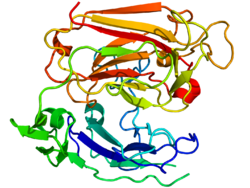Reelin
From Wikipedia, the free encyclopedia
| Reelin | |||||||||||
|---|---|---|---|---|---|---|---|---|---|---|---|
 Crystallographic structure of the third reelin repeat domain.[1] |
|||||||||||
|
|||||||||||
| Identifiers | |||||||||||
| Symbols | RELN; LIS2; PRO1598; RL | ||||||||||
| External IDs | OMIM: 600514 MGI: 103022 HomoloGene: 3699 GeneCards: RELN Gene | ||||||||||
| EC number | 3.4.21.- | ||||||||||
|
|||||||||||
| RNA expression pattern | |||||||||||
 |
|||||||||||
| More reference expression data | |||||||||||
| Orthologs | |||||||||||
| Species | Human | Mouse | |||||||||
| Entrez | 5649 | 19699 | |||||||||
| Ensembl | ENSG00000189056 | ENSMUSG00000042453 | |||||||||
| UniProt | P78509 | Q60841 | |||||||||
| RefSeq (mRNA) | NM_005045 | NM_011261 | |||||||||
| RefSeq (protein) | NP_005036 | NP_035391 | |||||||||
| Location (UCSC) | Chr 7: 103.11 – 103.63 Mb |
Chr 5: 21.88 – 22.34 Mb |
|||||||||
| PubMed search | [1] | [2] | |||||||||
Reelin has been suggested to be implicated in pathogenesis of several brain diseases. The expression of the protein has been found to be significantly lower in schizophrenia and psychotic bipolar disorder, but the cause of this observation remains uncertain as studies show that psychotropic medication itself affects reelin expression. Moreover, the epigenetic hypothesis aimed at explaining the changed levels[6] has received some contradictory evidence.[7][8] Total lack of reelin causes a form of lissencephaly. Reelin may also play a role in Alzheimer's disease, temporal lobe epilepsy and autism.
Reelin's name comes from the abnormal reeling gait of reeler mice,[9] which were later found to have a deficiency of this brain protein and were homozygous for mutation of the RELN gene. The primary phenotype associated with loss of reelin function is a failure of neuronal positioning throughout the developing central nervous system (CNS). The mice heterozygous for the reelin gene, while having little neuroanatomical defects, display the endophenotypic traits linked to psychotic disorders.[10]WIKIPEDIA
======================================================================
NEXT INTEREST AT CRBCM
No comments:
Post a Comment